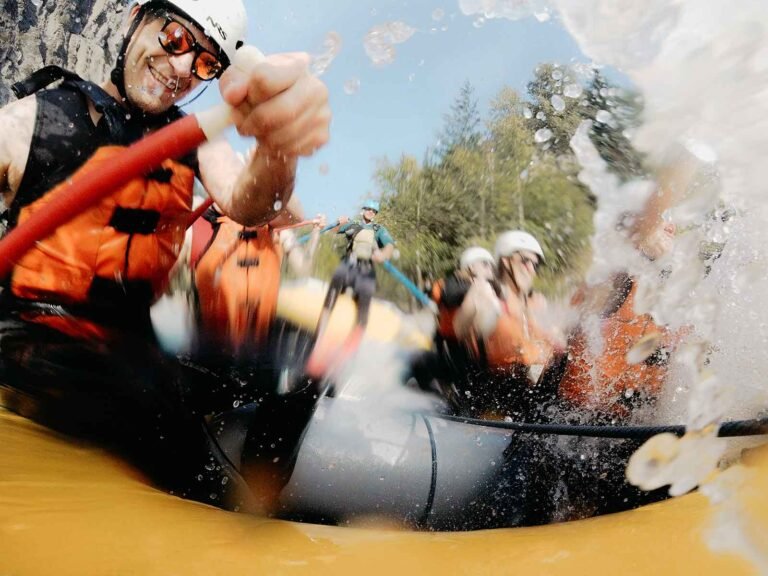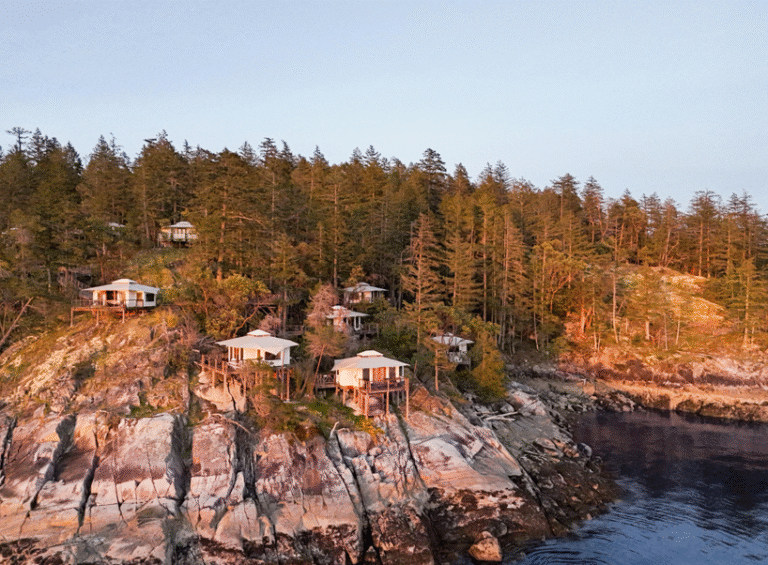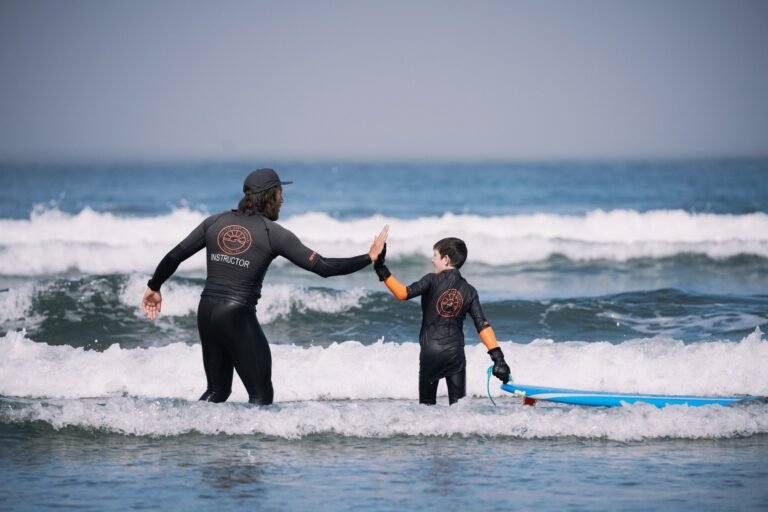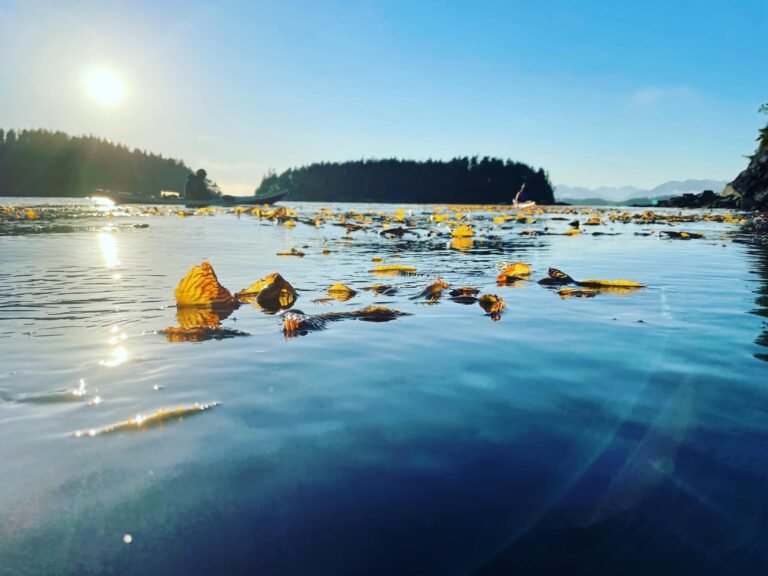Premier Listings for Cape Scott Park Trails
You would need over a week to hike the trails and see everything in Cape Scott Provincial Park, located 60 km west of Port Hardy on a well-maintained gravel road.
A good one-day hike may be made to San Josef Bay (2.5 km one way), where most backpackers set up on the sandy beach fronted by sea stacks. “San Jo” is beautiful, with its wildlife marshes and acres of sandy beaches – great wilderness exploring.
Hikers venturing further in should be properly equipped with backpacking gear and food. More experienced hikers face an eight-hour slog through some of the muddiest, most tortuous terrain of any trail in British Columbia to reach Cape Scott, a distance of 27 km from the parking lot. The heavier your pack, the less likely you are to be swept away by the winds that brew around the cape, but don’t count on it. A storm once blew so hard that it turned the lighthouse here sideways!
No matter what time of year you choose to visit this park, come equipped for storms. Carry a pair of high-top rubber boots in addition to wearing waterproof hiking boots. Expect to spend considerable amounts of time changing between the two. Be particularly careful on boardwalk sections, which can be quite slippery. In winter months, average rainfall is 22 to 35 cm per month, while in summer the average lightens to 8 to 10 cm. A good map to carry is NTS # 1021/09 and hydrographic chart # 3624 (Cape Cook to Cape Scott).
From the park’s main parking lot, historic trails traverse the upland areas in two directions, either north to Cape Scott or southwest to San Josef Bay. In order not to be cut off from hiking routes by incoming tides, be sure to carry and consult tide tables if you are engaged in extended exploration along the shoreline. There are more than 60 km of ocean frontage within the park, composed of rocky headlands and promontories interspersed with wide, sandy beaches such as at Nels bight.
The north coast extends about 18 km from Cape Scott to the park’s eastern boundary. It features three large bays at Experiment Bight, Nels Bight, and Nissen Bight, where backcountry explorers will find white sandy beaches interspersed with smaller bays that have steeper gravel beaches.
The western (Pacific) coast is vulnerable to southwesterly storms, which makes it a more rugged, exposed shoreline. The three sandy beaches here at Guise, Hansen and Lowrie Bays are smaller than the northern ones and are separated by long stretches of rocky coast.
Shellfish occur in abundance and can be harvested at low tide from the beach. Dig for razor, sand, mud, butter, and littleneck clams. A feast on these and a taste of hot clam broth will help ward off the chill while softening the memory of the trek. This park is home to both wolves and bears; food should be well cached and the Safety Guide to Bears should be observed.
Cape Scott’s strategic location means that it is a natural gathering place for migratory birds, particularly waterfowl, and sightings include sandhill cranes, trumpeter swans, pelagic cormorants, snipes, sandpipers, and plovers. Hansen Lagoon stretches for 5 km inland from the west coast and forms a large saltwater marsh and tidal mudflats where large numbers of birds gather.
The whole park is a naturalist’s paradise, and is an area with an immensely interesting history. Opened up by sturdy Danish Settlers in the late 1890s, the remote and rugged area was the scene of much toil, disillusion and hardship, as the settlers were gradually defeated in their efforts to tame and homestead the land.
BC Parks has made a trail leading to the top of Mount St. Patrick, which affords a magnificent view of the natural scenery. From here the trail leads down to Sea Otter Cove, approximately 10 km (about 2-1/2 hours). Lowrie Bay is about 2 km further.
Numerous other trails exist to Hansen Lagoon, Fisherman Bay, Nissen Bight, Nels Bight and Guise Bay. The Cape Scott Lighthouse Trail and the Lowrie Bay Trail are briefly described separately, as is the North Coast Trail, which runs along beaches and through forest from Shushartie Bay to Nissen Bight. At Nissen Bight it links up with the original Cape Scott Trail
Cape Scott Lighthouse Trail
Heading north from the trailhead, it is 17 km to Nels Bight, where nearly 2 km of flat white sand and pounding surf awaits you. On the way, hikers can camp at Eric Lake (3 km) or near a hiker’s shelter at 11 km. Walk through to Guise Bay for another beautiful surf beach and from there go north through sand dunes to the jeep road leading for about 2 km through lush vegetation to the lighthouse at Cape Scott.
Boil, filter or treat all drinking water before consuming. Water for human consumption can be found in the many streams at Cape Scott Provincial Park and is suitable for drinking if well-boiled, treated or filtered. Please note that drinking water is not available at the Cape Scott Lighthouse. At Nels Bight, a water pipe has been installed by the Parks staff in order to prevent pollution of the water supply.
Lowrie Bay Trail
Hikers wanting to get to Lowrie Bay should first hike the half-hour to San Josef Bay, a beautiful place, with wildlife marshes and acres of sandy beaches.
Most of the trail to San Josef Bay is surfaced with gravel and well graded. Camping at “San Jo” and exploring the area makes for an excellent trip, and you’re not likely to see too many other people – sound good?
Beyond “San Jo”, BC Parks has made a trail leading to the top of Mount St. Patrick, which affords a magnificent viewpoint. The top of this mountain is covered with crowberries.
From here a more primitive trail leads to Sea Otter Cove, approximately 10 km – about 2½ hours. Fresh water can be found a ways up the creek at the Cove. A further 2 km brings you to Lowrie Bay, and the open ocean.
North Coast Trail
The 43.1-km trail runs along beaches and through forest from Shushartie Bay to Nissen Bight. At Nissen Bight it links up with an existing 15-km section of the original Cape Scott Trail, which leads to the southern trailhead at San Josef River, increasing the total distance between the trailheads of what is known as the Cape Scott North Coast Trail to 61 km.
The North Coast Trail was completed in May 2008 after inclusion of the Nahwitti-Shushartie area into Cape Scott Provincial Park. The trail offers hikers a glimpse into wild, west coast ecosystems. The rugged trail passes through old and second-growth Sitka spruce, hemlock and cedar forests, upland bogs, riparian areas, across sand, gravel and cobble beaches, and past sea stacks, rocky headlands, and tidal pools.
Cape Scott Provincial Park is rich with First Nations history, with many signs of their historic presence evident in the park. Danish pioneers tried unsuccessfully to settle the area at the turn of the twentieth century, and the trail incorporates some of their original routes. History of Cape Scott Provincial Park.
The minimum recommended one-way hiking time is 5 days, although it is normally completed in 6 to 8 days. This is a very challenging route that is not recommended for inexperienced hikers. Many sections require hikers to climb over or along fallen trees, to cross through deep mud, and to use fixed ropes to climb up and over steep sections.
The North Coast Trail is situated in a remote, wilderness area, and hikers may see deer, elk, black bears, cougars, wolves, sea birds, seals, sea lions, grey whales, mink, and sea otters. Wildlife encounters are common in the park, so visitors should exercise caution.
The Cape Scott Trailhead and parking lot for Cape Scott Provincial Park is located at San Josef River, and can be accessed by car from Port Hardy on the Holberg Road, a 64-km drive over fairly good logging roads.
There is currently no road access to the other trailhead at Shushartie Bay, and hikers will have to use either a water taxi from Port Hardy (services operate in summer) or a seaplane to access the trail. Long-term plans for the park include construction of a road to Shushartie Bay and a vehicle-accessible campground.
NORTH COAST TRAIL OVERVIEW
Shushartie Bay Campsite to Skinner Creek Campsite
Distance: 8.1km (5 to 7 hours)
This is the longest section of inland trail and is considered by most to be the most challenging portion of the entire route. The trail reaches its maximum elevation of 225 metres along this section, and passes mainly through upland bog ecosystems. This section provides sensitive habitats for amphibians, fish and invertebrates, so please stay on the trail to avoid increased erosion and damage. There are stretches of boardwalk, but expect to be climbing up, over and around tree roots and stumps and through very muddy sections.
Three tent pads, a food cache, and a pit toilet are located on the hillside above the trailhead at Shushartie Bay. There is no water source at Shushartie Bay. If you are hiking from Skinner Creek, fill up your water bottles there. There is a designated campsite at Skinner Creek with a pit toilet and a food cache. There are no tent platforms but beach camping is possible. Skinner Creek is the only good water source along this section of trail.
Skinner Creek Campsite to Nahwitti River Campsite
Distance: 2.9km (1 to 1.5 hours)
It is possible to hike along the beach from Skinner Creek to Nahwitti River at low tide. However, this section can be very dangerous during high tides, and can be virtually impassable. A rough inland trail can be used to bypass the beach if necessary. There is one section of inland trail to be used at all times. Hanging floats at the end of the beach identify the access point. Tide tables should be consulted before attempting to hike the beach section.
There is a campsite with four tent platforms, a food cache, and a pit toilet located at Nahwitti River. The Nahwitti River can be used as a water source, but walk far enough upstream to avoid tidal influx.
Nahwitti River Campsite to Cape Sutil Campsite
Distance: 5km (2.5 to 4 hours)
From the Nahwitti River camp the trail heads south on an easy trail to the first cable car crossing. The ladders to the cable car platforms are very steep, and caution should be exercised, especially in wet weather. No more than two people, or 600 lbs/270 kgs, should use the cable car at one time.
Portions of the next section of trail are through dense forest where the trail can easily be lost. Look for trail markers to identify the path. Be aware that some areas may have old flagging tape delineating old logging tracks and are not marking the trail. The trail then heads up and over what is known as Long Leg Hill before descending down the longest set of stairs in Cape Scott Provincial Park.
The beach west of the Nahwitti stairs is impassable at high tide due to a rocky promontory. Wading past this section at high tide should not be attempted due to the risk of being swept out to sea. Plan your hike accordingly, by consulting a current tide table.
Camping at the eastern edge of the beach is possible during certain times of year if necessary. Ensure that you are set up well above the high tide line. There is a good water source located immediately east of the rocky promontory. The last stretch to the Cape Sutil campsite is characterized by steep, rugged headlands with extensive rope work. If necessary, remove your pack and lower it with the ropes provided.
Cape Sutil itself lies outside of the park boundary in an Indian Reserve. It is the former site of the First Nations village of “Nahwitti” and is rich in cultural heritage. Access to the reserve is restricted, so please refrain from visiting the Cape.
There is a ranger yurt located at Cape Sutil that is staffed with Park Facility Operators (PFOs) from May 15th to September 30th. The yurt is open the rest of the year for emergency use by the public. Please ensure that you leave the yurt in better condition than you found it. Do not wear caulk boots in the yurt, and use the food caches located behind the structure.
Beach camping is possible at Cape Sutil (there are no tent platforms at this site). There is a pit toilet located 50 meters up the trail at the eastern end of the beach. There is a food cache located behind the ranger yurt. There are only ephemeral water sources along this section of trail. Pack water from Nahwitti River or Irony Creek (depending on direction of travel).
Cape Sutil Campsite to Irony Creek Campsite (Shuttleworth Bight)
Distance: 7.8km (4 to 6 hours)
Pocket beaches and rocky headlands characterize this section of trail. Keep your eyes open for floats and buoys hanging near inland trail access points. Many beach sections can be traversed at low tide, but look for the adjacent inland routes during high waters. More rope work and steep sections can be expected along this stretch.
There is a creek ford immediately west of the Irony Creek campsite. Passage can be difficult under high flows (e.g. in early spring), and the rocks in the area are slippery at all times of year, in all weather conditions.
There is a campsite located on the west side of Irony Creek, in the middle of Shuttleworth Bight. There are four tent platforms, a food cache, and a pit toilet at this location. Irony Creek is the only good water source along this section of trail.
Irony Creek (Shuttleworth Bight) Campsite to Laura Creek Campsite
Distance: 11.8km (4 to 7 hours)
This section is predominantly coastal. Hikers will find themselves exposed to the effects of the open ocean, with little in the way of cover in inclement weather. Camping is possible along the pocket beaches north west of the cable car, but no facilities are provided. Consult tide tables to ensure high tides do not hinder progress along this section.
There is a short easy inland section to the second cable car crossing located at the Stranby River. Look for signs of the old corduroy settler’s road on the west side of the cable car.
Beach sections alternate between, sand, gravel and cobble while passing by innumerable tidal pools and rock shelves exposed at low tide. This section is teaming with wildlife. Bald eagles perched in old growth Sitka spruce, and black bears foraging in the beds of seaweed, are quite common. There is another creek ford east of the Laura Creek campsite. It is generally easy to cross, but rocks in this area are very slippery.
There is a designated campsite with four tent platforms, a food cache, and a pit toilet located approximately 100 meters west of Laura Creek. Laura Creek is the only good water source along this section of trail.
Laura Creek Campsite to Nissen Bight
Distance: 7.5km (2.5 to 4 hours)
This is the last section of inland trail before reaching the Nissen Bight trailhead. It begins and ends with easy sand beach walks before climbing back into the forest to traverse around the Nahwitti Cone. Boardwalks and stairways are common, but many sections are still very muddy. Look for the old settler’s road along this section, and stop for a break at Laughing Loon Lake – the North Coast Trail’s only lake (not suitable for swimming).
There are two significant creek crossings along this section. The first (when heading east to west) has a bridge with hand rail, but the second, located at Dakota Creek, does not. Do NOT attempt to walk across the log spanning the second creek. It is very slippery and unsafe. Either ford the creek or shimmy across the log.
Beach camping is possible on the entire length of Nissen Bight. A pit toilet and food cache are located at the western end of the beach. The water source is located at the eastern end of the beach near the North Coast Trail trailhead (approximately 900 meters from the pit toilet and food cache). At low tide walk approximately 50 meters east along the rocks, or at high tide take the inland trail that forks to the east off the North Coast Trail near the beach.
Nissen Bight to Cape Scott Trailhead
Distance: 15.4km (5 to 7 hours)
This section is part of the original Cape Scott trail. It is the easiest section of the North Coast trail and also the most maintained. There are many boardwalk sections, but still expect to get your feet muddy. Look for remnants of the Danish settlers along the entire route.
There is a campsite with three tent platforms and a pit toilet located at Fisherman River at kilometre 9.3 (from the Cape Scott trailhead). There is no food cache at this location. Fisherman River is the best water source along this section of trail.
There are eight tent platforms, a food cache, and a pit toilet located at Eric Lake at kilometre 3 (from the Cape Scott trailhead). Access to the lake is on the west side of the campground.
From Port Hardy you can reach the start of these trails in 2 hours, travelling west on the Holberg Road (Hwy 19) – about 65 km over rough roads.
From Holberg drive 3 km to where the old road to CFB Holberg intersects, then follow San Josef Main to the end, which is 500m past the entrance to the campground.






